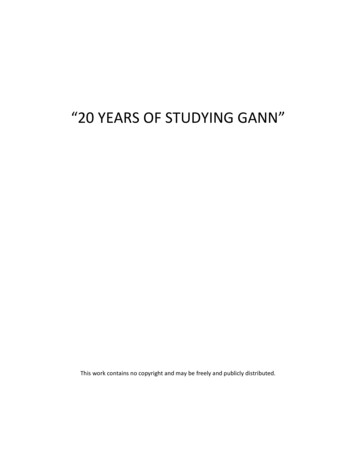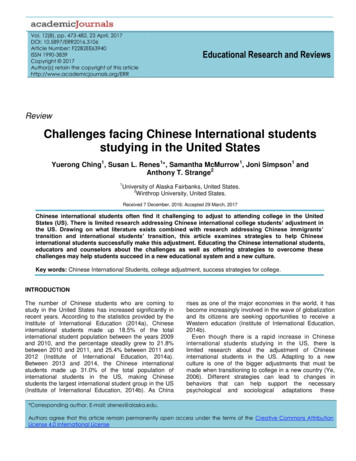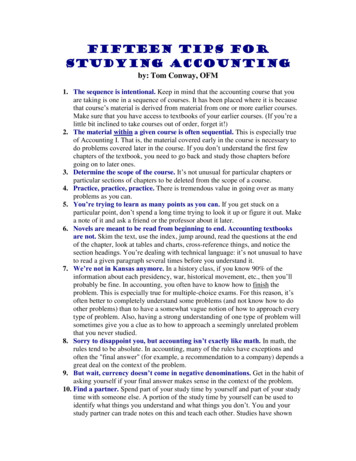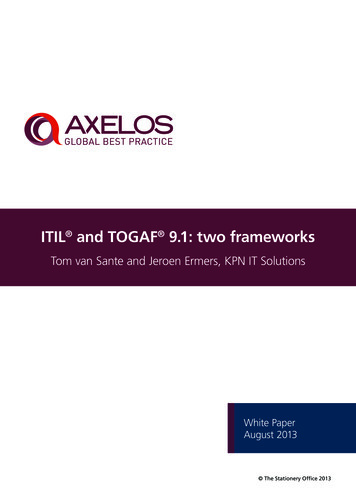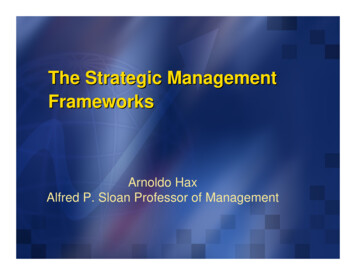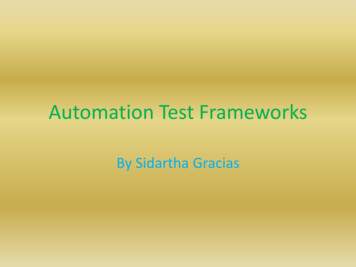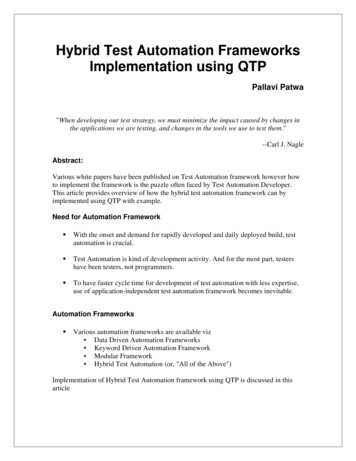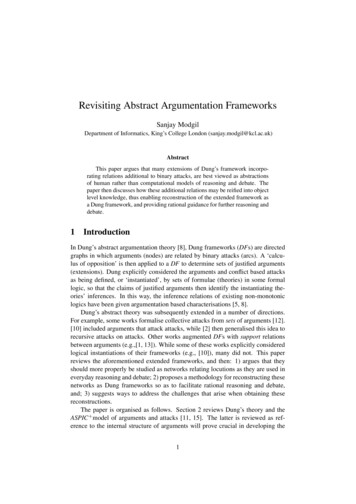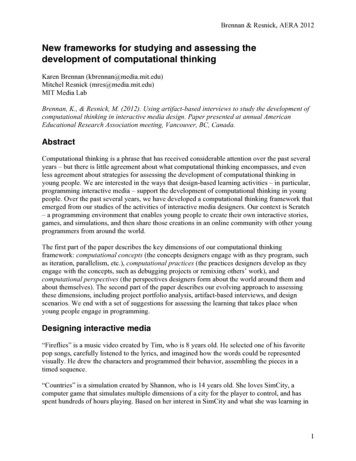
Transcription
Brennan & Resnick, AERA 2012New frameworks for studying and assessing thedevelopment of computational thinkingKaren Brennan (kbrennan@media.mit.edu)Mitchel Resnick (mres@media.mit.edu)MIT Media LabBrennan, K., & Resnick, M. (2012). Using artifact-based interviews to study the development ofcomputational thinking in interactive media design. Paper presented at annual AmericanEducational Research Association meeting, Vancouver, BC, Canada.AbstractComputational thinking is a phrase that has received considerable attention over the past severalyears – but there is little agreement about what computational thinking encompasses, and evenless agreement about strategies for assessing the development of computational thinking inyoung people. We are interested in the ways that design-based learning activities – in particular,programming interactive media – support the development of computational thinking in youngpeople. Over the past several years, we have developed a computational thinking framework thatemerged from our studies of the activities of interactive media designers. Our context is Scratch– a programming environment that enables young people to create their own interactive stories,games, and simulations, and then share those creations in an online community with other youngprogrammers from around the world.The first part of the paper describes the key dimensions of our computational thinkingframework: computational concepts (the concepts designers engage with as they program, suchas iteration, parallelism, etc.), computational practices (the practices designers develop as theyengage with the concepts, such as debugging projects or remixing others’ work), andcomputational perspectives (the perspectives designers form about the world around them andabout themselves). The second part of the paper describes our evolving approach to assessingthese dimensions, including project portfolio analysis, artifact-based interviews, and designscenarios. We end with a set of suggestions for assessing the learning that takes place whenyoung people engage in programming.Designing interactive media“Fireflies” is a music video created by Tim, who is 8 years old. He selected one of his favoritepop songs, carefully listened to the lyrics, and imagined how the words could be representedvisually. He drew the characters and programmed their behavior, assembling the pieces in atimed sequence.“Countries” is a simulation created by Shannon, who is 14 years old. She loves SimCity, acomputer game that simulates multiple dimensions of a city for the player to control, and hasspent hundreds of hours playing. Based on her interest in SimCity and what she was learning in1
Brennan & Resnick, AERA 2012history class, she developed a simulation about virtual countries, with the player makingdecisions about how to respond to economic, agricultural, and political crises.“10 Levels” is a game created by Renita, who is 10 years old, and her younger brother. Sheplayed a similar game on a popular game site and decided to design her own version of the game,which involves navigating the main character from the start of the level to the end of the levelwithout colliding with hazards (such as spikes, fireballs, and trapdoors).All three of these projects were created by young people using Scratch, a computationalauthoring environment developed by the Lifelong Kindergarten research group at the MIT MediaLab. With Scratch, young people can design their own interactive media – including stories,games, animations, and simulations – by snapping together programming-instruction blocks, justas one might snap together LEGO bricks or puzzle pieces (Resnick et al., 2009).In addition to the authoring environment, there is an online community where young people canshare their projects, just as videos are shared on YouTube. The Scratch online community, whichwas launched in May 2007, has grown steadily over the past five years; hundreds of thousands ofyoung creators (mostly between the ages of 8 and 16) have shared more than 2.5 million projects.Community members can interact with projects (try them out, or download to see how theywork) and with other members (leave comments, or mark someone as a friend) (Brennan,Resnick, & Monroy-Hernandez, 2010; Brennan, Valverde, Prempeh, Roque, & Chung, 2011).Computational thinkingHow do we describe what Tim, Shannon, and Renita are learning as they participate as designersof interactive media with Scratch? What is the learning that is supported by programminginteractive media, as opposed to making a video with editing software or playing a video game?We have been intrigued by the phrase computational thinking as a device for conceptualizing thelearning and development that take place with Scratch. Although computational thinking hasreceived considerable attention over the past several years, there is little agreement on what adefinition for computational thinking might encompass (Allan et al., 2010; Barr & Stephenson,2011; National Academies of Science, 2010). Cuny, Snyder, and Wing (2010) definecomputational thinking as “the thought processes involved in formulating problems and theirsolutions so that the solutions are represented in a form that can be effectively carried out by aninformation-processing agent” – a description that aptly (if somewhat tersely) frames the work ofcomputational creators.The phrase computational thinking helps us think about learning with Scratch, and, in turn, webelieve that programming with Scratch provides a context and set of opportunities forcontributing to the active conversations about computational thinking. We are interested in theways that design-based learning activities – in particular, programming interactive media –support the development of computational thinking in young people. Part of this interest isfuelled by the growing availability of tools that enable young people to design their owninteractive media. But, more importantly, this interest is rooted in a commitment to learning2
Brennan & Resnick, AERA 2012through design activities, a constructionist approach to learning that highlights the importance ofyoung people engaging in the development of external artifacts (Kafai & Resnick, 1996).Over the past several years, by studying activity in the Scratch online community and in Scratchworkshops, we have developed a definition of computational thinking that involves three keydimensions: computational concepts (the concepts designers employ as they program),computational practices (the practices designers develop as they program), and computationalperspectives (the perspectives designers form about the world around them and aboutthemselves). Observation and interviews have been instrumental in helping us understand thelongitudinal development of creators, with participation and project portfolios spanning weeks toseveral years, and workshops have been instrumental in understanding the practices of thecreator-in-action.Computational thinking conceptsAs young people design interactive media with Scratch, they engage with a set of computationalconcepts (mapping to Scratch programming blocks) that are common in many programminglanguages. We have identified seven concepts that are highly useful in a wide range of Scratchprojects, and which transfer to other programming (and non-programming) contexts: sequences,loops, parallelism, events, conditionals, operators, and data. For each concept, we provide adefinition of the concept and a concrete example from a Scratch project.Concept: SequencesA key concept in programming is that a particular activity or task is expressed as a series ofindividual steps or instructions that can be executed by the computer. Like a recipe, a sequenceof programming instructions specifies the behavior or action that should be produced. Forexample, the cat object can be programmed to move a short distance across the screen anddeclare, “I’m programming!” with the sequence of instructions shown in Figure 1.Figure 1. Example of an instruction sequence.Concept: LoopsIn the previous example, the cat was programmed to move 10 steps, wait 0.2 seconds, and thento repeat the action – moving another 10 steps, and waiting another 0.2 seconds. What if, instead3
Brennan & Resnick, AERA 2012of a single repetition of the action, we want the cat to move and wait three more times? We couldeasily add more move and wait blocks. But what if we wanted the cat to move and wait 50 or 100or 1000 more times? Loops are a mechanism for running the same sequence multiple times.Figure 2 illustrates how a loop can be used to express a sequence of instructions more succinctly.Instead of moving and waiting with 8 consecutive blocks, we use three blocks: move 10 steps,followed by wait 0.2 secs, enclosed by repeat with the desired number of iterations.Figure 2. A sequence of repeated instructions expressed as a loop.Concept: EventsEvents – one thing causing another thing to happen – are an essential component of interactivemedia. For example, a start button triggering the beginning of a music video, or the collision oftwo objects causing a game’s score to increase. Figure 3 illustrates different situations in whichan event will produce an action: (1) when the green flag is clicked, the object will turn forever in15 degree increments, (2) when the space key is pressed, the object will move up and down, and(3) when the object is clicked with the mouse, it will display a speech bubble for 2 seconds thatsays, “Hello!”Figure 3. Examples of events producing actions.Concept: ParallelismMost modern computer languages support parallelism – sequences of instructions happening atthe same time. Scratch supports parallelism across objects. For example, a dance party scenemight involve several characters dancing simultaneously, each with a unique sequence of danceinstructions. Scratch also supports parallelism within a single object. In Figure 4, the Scratch cathas been programmed to perform three sets of activities in parallel in response to the when greenflag clicked event: (1) continuously play a background soundtrack, (2) continuously dance backand forth, and (3) introduce itself and its interests.4
Brennan & Resnick, AERA 2012Figure 4. Example of parallelism within a single object.Concept: ConditionalsAnother key concept in interactive media is conditionals – the ability to make decisions based oncertain conditions, which supports the expression of multiple outcomes. Figure 5 illustrates theuse of a conditional – the if block – to determine the visibility of an object. If the cube istouching color yellow, then it should fade out and reappear for the next level of the game;otherwise, it should remain visible.Figure 5. Example of conditionals.Concept: OperatorsOperators provide support for mathematical, logical, and string expressions, enabling theprogrammer to perform numeric and string manipulations. Scratch supports a range ofmathematical operations (including addition, subtraction, multiplication, division, as well as5
Brennan & Resnick, AERA 2012functions like sine and exponents) and string operations (including concatenation and length ofstrings). Figure 6 illustrates Scratch’s operator blocks.Figure 6. Operator blocks.Concept: DataData involves storing, retrieving, and updating values. Scratch currently offers two containers fordata: variables (which can maintain a single number or string) and lists (which can maintain acollection of numbers or strings). Keeping score in a game is a frequent motivator for youngdesigners to explore variables. Figure 7 demonstrates how a variable is used to keep score in agame; for each little fish eaten by the large fish, the score increases by 1.Figure 7. Using a variable to keep score.Computational thinking practicesFrom our interviews with and observations of young designers, it was evident that framingcomputational thinking solely around concepts insufficiently represented other elements ofdesigners’ learning and participation. The next step in articulating our computational thinkingframework was to describe the processes of construction, the design practices we saw kids6
Brennan & Resnick, AERA 2012engaging in while creating their projects. Computational practices focus on the process ofthinking and learning, moving beyond what you are learning to how you are learning.Although the young people we interviewed had adopted a variety of strategies and practices fordeveloping interactive media, we observed four main sets of practices: being incremental anditerative, testing and debugging, reusing and remixing, and abstracting and modularizing.Interactive media creation is a powerful context for developing these practices, which are usefulin a variety of design activities, not just programming. To illustrate these practices in action, weuse the case of Renita and her younger brother, and their process for developing the multi-stageobstacle/adventure game “10 Levels”.Practice: Being incremental and iterativeDesigning a project is not a clean, sequential process of first identifying a concept for a project,then developing a plan for the design, and then implementing the design in code. It is an adaptiveprocess, one in which the plan might change in response to approaching a solution in small steps.In conversations with Scratchers, they described iterative cycles of imagining and building –developing a little bit, then trying it out, and then developing further, based on their experiencesand new ideas. Renita described this process with “10 Levels”, and how she used each iterationas an opportunity to solicit feedback and new ideas:I: OK, this is a complicated program. How long have you been working on it?R: Maybe three, or maybe two, weeks.I: Are you working on it every day?R: Like off and on, maybe even a month. Whenever I finished one of the levels, I wouldshow it to my brother.I: You talked a bit about how you did a lot of the programming and your brother helpedwit
programming interactive media – support the development of computational thinking in young people. Over the past several years, we have developed a computational thinking framework that emerged from our studies of the activities of interactive media designers. Our context is Scratch – a programming environment that enables young people to create their own interactive stories, games,
